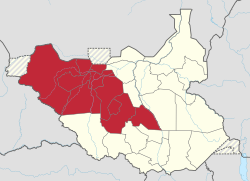Bahr el Ghazal (region of South Sudan)
| Bahr el Ghazal | |
|---|---|
| Region | |
 Location of the region in South Sudan. |
|
| Country |
|
| Capital | Wau, South Sudan |
| Area | |
| • Total | 210,785.57 km2 (81,384.76 sq mi) |
| Population (2014 Estimate) | |
| • Total | 4,296,600 |
| • Density | 20/km2 (53/sq mi) |
| Time zone | EAT (UTC+3) |
The Bahr el Ghazal is a region of northwestern South Sudan. Its name comes from the river Bahr el Ghazal.
The region consisted of the erstwhile states of Northern Bahr el Ghazal, Western Bahr el Ghazal, Lakes, and Warrap. It borders the Central African Republic to the west. It is an area of swamps and ironstone plateaus inhabited mainly by the Dinka people, who make their living through subsistence farming and cattle herding plus Luwo and Fartit tribes.
It was historically subject to raids by the Fur invaders from the neighboring region of Darfur. The khedive of Egypt made Bahr al Ghazal his province in 1864. Powerful native merchants, who set themselves up as princes complete with armies, emerged in the area. The most powerful of them, al-Zubayr, fought and defeated a joint Turkish/Egyptian force sent to Bahr el Ghazal in 1873. The khedive conceded defeat and made Bahr el Ghazal a nominal province of Egypt, with al-Zubayr as its governor. It came under Mahdist control in 1884, when Karam Allāh Muḥammad Kurkusāwī was appointed governor (emir)1738
The region was visited by the anthropologist Edward Evans-Pritchard in 1929. The region was later incorporated into Anglo-Egyptian Sudan and became the ninth province after being split from Equatoria in 1948, and later a province, and then state, under the Republic of Sudan. In 1996, the region was divided into the four current districts as part of an administrative reorganisation of the country. During the condominium period of joint British-Egyptian rule, the area was administered by British district officers; because of annual flooding and difficult travelling conditions, the area became part of what was known colloquially in the British Sudan Service as "The Bog", with British District Officers known as "Bog Barons" (Wyndham, 1937).
...
Wikipedia
